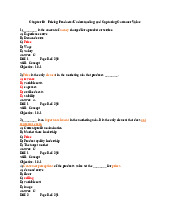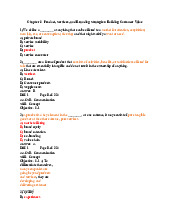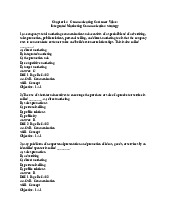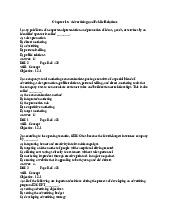













Preview text:
lOMoAR cPSD| 58097008 Vinamilk case lOMoAR cPSD| 58097008 Mcq chap 8, 10, 12, 14,15 Case study: Vinamilk
Câu 1: analyze fresh milk products . Đánh giá mức độ sử dụng 3 mức độ của product
concept. - chapter 8 - giá trị khách hàng cốt lõi, sản phẩm thực tế, sản phẩm tăng cường
Câu 2: evaluate how VNM sử dụng chiến dịch product line fil ing and stretching in yogurt portfolio
Câu 3: In your opinion, which element of the VNM promotion mix is the most impactful - chap 14, 15
Câu 4: Discuss perfect relation in campaign sữa học đường.
Câu 1: Analyze Vinamilk fresh milk product by using 3 levels of product
1. Core Customer Value● Essential Benefits:
○ The fundamental value of Vinamilk's fresh milk lies in its promise of health,
nutrition, and wel ness. Milk is a vital source of calcium, protein, and essential
vitamins, and Vinamilk positions its fresh milk as an essential part of a
balanced diet, particularly for children and families. ● Emotional Benefits:
○ Vinamilk's fresh milk also provides emotional satisfaction by representing care
for loved ones and promoting a healthy lifestyle. 2. Actual Product● Product Features:
○ Variety: Vinamilk offers a range of fresh milk products, including regular fresh
milk, low-fat milk, and organic options.
○ Quality: Their milk is sourced from high-standard dairy farms, ensuring purity and freshness.
○ Processing: UHT (Ultra-High Temperature) processing for long shelf life while retaining nutrients. ● Design and Packaging:
○ Attractive, eco-friendly packaging emphasizes the freshness and purity of the product.
○ Clear labeling highlights nutritional benefits and certifications (e.g., organic, ISO standards). ● Branding:
○ Vinamilk is a trusted household name in Vietnam, synonymous with quality,
innovation, and sustainability.
○ Advertising campaigns reinforce the product's credibility and nutritional value. 3. Augmented Product
● Customer Support Services:
○ Customer hotlines and online platforms provide information about products and address queries.
○ Free delivery options for certain customer segments (e.g., bulk orders). ● Additional Benefits: lOMoAR cPSD| 58097008
○ Organic certifications for select products enhance credibility and cater to health-conscious consumers.
○ Educational campaigns about milk's role in nutrition are often bundled with the product's promotion. ● Emotional Connection:
○ Vinamilk aligns its fresh milk products with themes of family, love, and
sustainability in its marketing, creating a strong emotional bond with consumers.
Câu 2: Evaluation of Vinamilk's Product Line Filling and Stretching
Campaign in the Yogurt Portfolio 1. Product Line Filling
Vinamilk ensures the yogurt product line addresses gaps in the market by introducing
variations that target specific consumer demands. ● Flavor Variants:
○ Multiple fruit-based flavors (e.g., strawberry, mango, blueberry) appeal to
younger consumers and families looking for tasty, healthy snacks.
○ Dessert-inspired yogurts attract those who want indulgent options without guilt. ● Texture and Format:
○ Smooth Yogurts: Traditional creamy yogurt for conventional consumers.
○ Drinking Yogurts: Portable, on-the-go options for busy lifestyles.
○ Greek Yogurts: High-protein options for fitness and health enthusiasts. ● Functional Benefits:
○ Probiotic yogurts targeting digestive health.
○ Yogurts are enriched with vitamins and minerals to support immunity and general wellness.
This approach ensures that Vinamilk’s yogurt line caters to diverse tastes, lifestyles,
and health needs, maximizing market share.
2. Product Line Stretching
Vinamilk stretches its yogurt portfolio both upward and downward to attract different consumer segments:
● Upward Stretching: Premium Yogurt Lines:
○ Organic yogurts for health-conscious and affluent customers.
○ Imported-style yogurts like Icelandic and Greek yogurts for consumers
seeking unique and luxurious options.
○ These products are priced higher, targeting those wil ing to pay for superior quality and exclusivity.
● Downward Stretching: Affordable Options:
○ Economical yogurt packs and smaller serving sizes make yogurt accessible to price-sensitive consumers.
○ Bundled promotions for schools and bulk buyers. ● Horizontal Stretching:
○ Plant-Based Yogurts: For vegan or lactose-intolerant customers, offering
alternatives made from almond, soy, or coconut milk. lOMoAR cPSD| 58097008
○ Seasonal or limited-edition yogurts to attract curious consumers and maintain interest in the product line.
3. Outcomes of the Campaign● Market Penetration:
○ Fil ing the product line ensures Vinamilk meets all customer needs, enhancing brand loyalty.
○ Stretching allows Vinamilk to expand its reach to both premium and budget segments.
● Competitive Advantage: By offering a broad range of options, Vinamilk positions itself
as the go-to brand for yogurt, outperforming competitors.
● Brand Reputation: The inclusion of organic, functional, and plant-based options
showcases Vinamilk as a forward-thinking and inclusive brand.
Câu 3: In your opinion, which element of the Vinamilk promotion mix is the most impactful?
The most impactful element is advertising, due to its wide reach and ability to build a strong brand image. 1. Wide Reach:
● Vinamilk uses a mix of traditional and digital media to reach a broad audience.
○ Television: Engages families through emotional commercials that highlight
health, family care, and trust.
○ Social Media: Active presence on platforms like Facebook, YouTube, and
Instagram ensures targeted communication, especially with younger, techsavvy consumers.
2. Emotional Storytelling:
● Advertising campaigns often use themes of family love, childhood growth, and national pride.
Example: Ads showcasing children drinking Vinamilk to grow strong and healthy resonate
deeply with parents. 3. Consistency in Branding:
● The consistent use of slogans, visuals, and messages ensures consumers associate
Vinamilk with health, quality, and reliability.
Example: "Vinamilk - For the Future of Vietnam" reinforces its role in national development and societal well-being.
4. Innovation in Content:
● Leveraging trends like influencer marketing and short-form videos to stay relevant.
● Collaborations with nutritionists and health professionals enhance credibility and trust.
While sales promotions (e.g., discounts or free samples) are effective for short-term
gains, advertising solidifies brand loyalty and long-term market leadership.
Câu 4: Discuss the perfect relationship in Vinamilk campaign "Sữa học đường"
The "Sữa Học Đường" (School Milk Program) campaign shows a perfect synergy
between corporate social responsibility (CSR), government collaboration, and community engagement.
This relationship ensures the campaign achieves its objectives of improving
children’s nutrition and physical development while enhancing Vinamilk’s brand reputation. lOMoAR cPSD| 58097008
1. Corporate Social Responsibility (CSR)
Vinamilk’s involvement in the campaign reflects its commitment to social welfare:
● Objective: Provide high-quality milk at subsidized prices or for free to schoolchildren,
particularly in rural and underprivileged areas. ● Execution:
○ Develops milk products tailored to children’s nutritional needs.
○ Al ocates resources for production, distribution, and awareness activities to ensure program success. ● Impact on Vinamilk:
○ Positions the company as a socially responsible brand.
○ Builds trust and goodwil with families, schools, and the community.
2. Government Collaboration
The campaign aligns with national policies on children’s health and development: ● Policy Support:
○ The program is part of Vietnam’s national strategy to improve nutrition among
schoolchildren, with government backing ensuring its credibility and reach. ● Implementation:
○ Joint efforts between Vinamilk and government bodies streamline logistics,
distribution, and program monitoring.
○ Policies like subsidized pricing help make milk accessible to a wider demographic. ● Mutual Benefits:
○ The government achieves public health objectives, while Vinamilk strengthens
its position as a key partner in national development.
3. Community Engagement
The program fosters strong connections with schools, parents, and local communities: ● Parents:
○ Campaigns educate parents on the importance of milk for children’s growth
and development, ensuring high participation rates.
○ Affordable options reduce financial barriers for low-income families. ● Schools:
○ Active involvement of schools ensures smooth implementation and continuous feedback. ● Children:
○ The campaign directly impacts children by improving their daily nutrition,
which supports academic performance and overal health.
4. Outcomes of the Perfect Relationship● For Society:
○ Enhanced child nutrition leads to better health outcomes and contributes to
Vietnam’s long-term human capital development. ● For the Government:
○ The campaign supports national nutrition goals while leveraging private sector resources for implementation. ● For Vinamilk:
○ Brand Equity: Strengthens its image as a socially responsible and communityoriented company. lOMoAR cPSD| 58097008
○ Market Reach: Introduces Vinamilk products to a new generation of
consumers, fostering brand loyalty early on. Summary lOMoAR cPSD| 58097008
Chapter 8: Products, Services, and Brands: Building Customer Value
● Product is anything that can be offered in a market for attention, acquisition, use, or
consumption that might satisfy a need or want.
● Services are a form of product that consists of activities, benefits, or satisfactions
and that is essential y intangible and does not result in the ownership of anything.
● Products are a key element in the overall market offering. Marketing mix planning
begins with building an offering that brings value to target customers. This offering
becomes the basis on which the company builds profitable customer relationships.
● A company’s market offering often includes both tangible goods and services.
○ At one extreme, the market offer may consist of a pure tangible good, such
as soap; no services accompany the product.
○ At the other extreme are pure services, for which the market offer consists
primarily of a service. Examples include a doctor’s exam and financial services.
○ Between these two extremes, however, many goods-and-services
combinations are possible.
● To differentiate themselves, many companies are going beyond products and
services, they are developing and delivering customer experiences
● Product planners need to think about products and services on three levels. Each
level adds more customer value.
○ The most basic level is the core customer value, which addresses the
question: What is the buyer real y buying?
○ At the second level, product planners must turn the core benefit into an
actual product. They need to develop product and service features, a
design, a quality level, a brand name, and packaging.
○ Final y, product planners must build an augmented product around the core
benefit and actual product by offering additional consumer services and benefits.
● Two types of products: Consumer products and Industrial products
○ Consumer products: products and services bought by final consumers for personal consumption.
■ Convenience products: consumer products and services that the
customer usually buys frequently, immediately, and with a minimum comparison and buying effort.
■ Shopping products: less frequently purchased consumer products
and services that the customer compares carefully on suitability, quality, price, and style.
■ Specialty products: consumer products and services with unique
characteristics or brand identification for which a significant group of
buyers is wil ing to make a special purchase effort. ■
Unsought products: consumer products that the consumer does not
know about or knows about but does not normally think of buying.
○ Industrial products: products purchased for further processing or for use in conducting a business.
■ Materials and parts: include raw materials and manufactured materials and parts. lOMoAR cPSD| 58097008
■ Capital items: industrial products that aid in the buyer’s production or
operations, including installations (major purchases such as buildings
and fixed equipment) and accessory equipment (shorter life like
portable factory equipment and tools and office equipment).
■ Supplies and services: include operating supplies, repair and
maintenance items, and business services.
● Organizations, Persons, Places, and Ideas
○ Organization marketing consists of activities undertaken to create, maintain,
or change the attitudes and behaviors of target consumers toward an organization.
○ Person marketing consists of activities undertaken to create, maintain, or
change the attitudes or behavior of target consumers toward particular people.
○ Place marketing consists of activities undertaken to create, maintain, or
change the attitudes and behavior toward particular places.
○ Social marketing uses commercial marketing concepts to influence
individuals’ behavior to improve their well-being and that of society. ● lOMoAR cPSD| 58097008 Another sum but GPT lOMoAR cPSD| 58097008
Chapter 8: Products, Services, and Brands: Building Customer Value 1. What is a Product?
● Definition: Anything offered in a market for attention, acquisition, or consumption that satisfies a need/want.
● Services: Activities or benefits that are intangible and do not result in ownership.
● Experiences: Many firms combine products and services to create unique customer
experiences (e.g., Starbucks sells the “Starbucks Experience”).
2. Product and Service Classifications ● Consumer Products:
○ Convenience Products: Frequently bought with minimal effort (e.g., candy, fast food).
○ Shopping Products: Bought less often, requiring comparison (e.g., furniture, electronics).
○ Specialty Products: Unique characteristics, strong brand loyalty (e.g.,
designer clothing, luxury cars).
○ Unsought Products: Products not actively sought until needed (e.g., insurance, funeral services).
● Industrial Products:
○ Materials and Parts: Raw materials (e.g., wheat, steel).
○ Capital Items: Used in production (e.g., machinery).
○ Supplies and Services: Maintenance and operating supplies (e.g., office supplies). ● Other Categories:
○ Organization Marketing: Branding for firms (e.g., corporate identity campaigns).
○ Person Marketing: Promoting individuals (e.g., politicians).
○ Place Marketing: Promoting locations (e.g., tourism campaigns).
○ Social Marketing: Promoting ideas (e.g., public health campaigns).
3. Product and Service Decisions
● Individual Product Decisions:
○ Quality: Performance and consistency (e.g., Chick-fil-A focuses on service quality).
○ Features: Added benefits (e.g., smartphone features).
○ Design/Style: Visual appeal and usability.
○ Branding: Identity that differentiates a product.
○ Packaging and Labeling: Protection, promotion, and information for consumers.
○ Support Services: Enhancing customer experience (e.g., Lexus’ service programs).
● Product Line Decisions: lOMoAR cPSD| 58097008
○ Length: Number of items in the product line.
○ Stretching: Extending product range up/downmarket.
○ Filling: Adding more products to existing ranges.
● Product Mix Decisions: lOMoAR cPSD| 58097008 ○
Width: Number of product lines.
○ Depth: Variations within each product line.
○ Consistency: Alignment across the mix (e.g., Colgate’s care-focused products). 4. Services Marketing
● Unique Characteristics:
○ Intangibility: Services cannot be touched.
○ Inseparability: Produced and consumed simultaneously.
○ Variability: Quality depends on the provider.
○ Perishability: Cannot be stored for later use. ● Strategies:
○ Service-Profit Chain: Links service profits to employee and customer satisfaction.
○ Internal Marketing: Motivating staff for superior service.
○ Interactive Marketing: Quality depends on buyer-seller interaction. 5. Branding Strategy
● Brand Equity: Customer perception that builds trust and loyalty.
● Brand Positioning: Focus on attributes, benefits, or values. ● Brand Development:
1. Line Extensions: New flavors/variations.
2. Brand Extensions: Moving into new categories.
3. Multibrands: Launching multiple brands in the same category.
4. New Brands: Completely new offerings.
Chapter 10: Pricing: Understanding and Capturing Customer Value 1. What is Price?
● Definition: The value exchanged for benefits received through a product/service.
● Importance: Determines profitability, competitive position, and perceived value.
2. Major Pricing Strategies
● Customer Value-Based Pricing:
○ Good-Value Pricing: Balances quality and price (e.g., EDLP at Walmart).
○ Value-Added Pricing: Justifies higher prices by adding features (e.g., Apple products).
● Cost-Based Pricing:
○ Fixed Costs: Do not change with production level (e.g., rent). lOMoAR cPSD| 58097008 ○
○ Variable Costs: Vary with production (e.g., materials).
○ Cost-Plus Pricing: Adding a markup percentage.
○ Break-Even Pricing: Ensures costs are covered or targeted profits are achieved.
● Competition-Based Pricing:
Pricing based on competitors’ strategies and offerings (e.g., Caterpil ar’s
premium prices for heavy equipment). 3. Pricing Factors ● Internal:
○ Marketing strategies, costs, and organizational goals. ● External:
○ Market demand, competition, economic conditions, regulations.
○ Price elasticity: Measures demand responsiveness to price changes.
Chapter 12: Marketing Channels: Delivering Customer Value
1. Marketing Channels and Their Importance
● Definition: Distribution networks that make products accessible to customers. ● Functions:
1. Information: Sharing product knowledge.
2. Promotion: Generating demand.
3. Matching: Customizing products for specific markets.
4. Physical Distribution: Logistics to move goods.
5. Financing and Risk Management: Handling payments and risks. 2. Channel Types
● Direct Channels: Producers sell directly (e.g., online sales).
● Indirect Channels: Use intermediaries like wholesalers and retailers. 3. Channel Strategies
● Vertical Marketing Systems (VMS):
○ Corporate: Unified ownership (e.g., Zara controlling production and sales).
○ Contractual: Independent firms collaborating through contracts (e.g., franchises).
○ Administered: Leadership through size/power (e.g., Walmart).
● Horizontal Marketing Systems:
○ Collaboration between companies at the same level (e.g., Target partnering with CVS). lOMoAR cPSD| 58097008 ○
● Multichannel Distribution:
○ Firms use multiple channels to reach customers (e.g., online, retail, and wholesale). ● Disintermediation:
○ Bypassing traditional intermediaries (e.g., Netflix’s streaming model replacing DVD rental stores).
4. Logistics and Supply Chain Management ● Key Functions:
○ Warehousing: Storage solutions.
Inventory Management: Balancing supply with demand.
○ Transportation: Efficient delivery methods.
○ Information Management: Data flow for tracking.
● Integrated Supply Chains:
○ Focused on minimizing costs while maximizing service levels (e.g., Oracle software for logistics).



